

In both our terrestrial and coastal sites we initiate community-led SMART patrol units that enable communities and government agencies to protect ecosystems in tandem. In our terrestrial sites, we identify, train, and equip local community members in using the Spatial Monitoring and Reporting Tool (SMART) to protect their forests in tandem with government park rangers. Teams are made up of 3 to 4 community members, 1 government staff, and 1 of our program team members. These teams carry out 7-10 days per month along paths generated by the SMART software based on historical data. Along with creating opportunities to track data on wildlife encounters, the SMART tool also allows tracking incidents of poaching and other illegal activity inside the protected forests. In our coastal site in Kubu Raya, SMART patrols are carried out by boats 3 days a week (12 days a month). These dates are chosen randomly to create uncertainty in the patrol schedules.
Community-led SMART patrols work best in areas where communities have rights over, or co-management, of a conservation area. For our work in West Kalimantan we have applied SMART patrols both to community conservation areas (forests and fisheries), as well as co-management of protected areas between government management authorities and local communities.
Several important lessons have been learned. First, the entry points to SMART patrols are extremely important. For most communities in the global south it is likely that this is a sensitive topic, and community members may feel that their livelihoods are threatened by the creation of a patrol team. We have learned that a viable entry point is phrasing SMART patrols a management and protection tool that helps communities to (i) keep outsiders who may be stealing their resources out, and (ii) enforce community participatory management agreements. Second, SMART patrols do require a learning curve and we highly recommend that NGOs ensure that each patrol team has one fully-trained and well-versed staff member accompanying patrols for the first year (or longer). Third, when implementing this in protected areas, it is essential to bring government park rangers and community members together over patrolling. This further supports a strong partnership between the two entities that is essential for long-term management of a protected or conservation area.